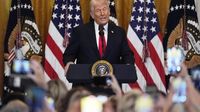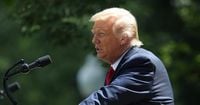President Donald Trump is poised to unveil a sweeping set of reciprocal tariffs on Wednesday, April 2, 2025, a day he has dubbed "Liberation Day." The announcement is expected to have far-reaching implications for the U.S. economy and global trade relations, as Trump aims to rectify what he describes as unfair trade practices by other nations.
White House press secretary Karoline Leavitt stated on Tuesday that April 2, 2025, will be remembered as one of the most significant days in modern American history, with the tariffs taking effect immediately. The administration's strategy appears to be a bold attempt to boost U.S. manufacturing and punish countries that Trump claims have exploited American trade policies.
In the lead-up to the announcement, Trump has emphasized that his tariffs will be lower than those imposed by other countries, stating, "We are going to be very nice by comparison to what they were. The numbers will be lower than what they have been charging us, and in some cases, maybe substantially lower." He insists that these measures will bring "tremendous wealth back to our country" and herald a rebirth for the American economy.
However, economists are warning that the tariffs could lead to significant economic repercussions. The Budget Lab at Yale University estimates that a flat 20% universal tariff could cost the average household an additional $3,400 to $4,200 annually. This figure is alarming, especially considering that the U.S. currently enjoys a relatively low unemployment rate of 4.1%. Critics argue that the tariffs could stifle economic growth, raise consumer prices, and disrupt established supply chains.
Trump's impending tariffs are not without precedent. Recent announcements have already included 25% taxes on auto imports and expanded penalties on steel and aluminum. These earlier measures have contributed to an average tariff rate in the U.S. of 12%, the highest since World War II, with projections suggesting that the new tariffs could elevate this rate to 18% or more.
The political landscape surrounding the tariffs is fraught with tension. Democrats, including Senate leader Chuck Schumer, have criticized the tariffs as a means for Trump to fund tax cuts that disproportionately benefit the wealthy. Schumer stated, "Almost everything they do, including tariffs, it seems to me, is aimed at getting those tax cuts for the wealthy." This sentiment is echoed by members of the Biden administration, who argue that Trump's previous tariffs failed to deliver the promised manufacturing renaissance.
In the face of potential pushback, countries like Canada and members of the European Union are preparing countermeasures. Canada has already implemented retaliatory tariffs in response to Trump's previous actions, while the EU has threatened to impose taxes on $28 billion worth of U.S. goods. European Commission President Ursula von der Leyen has asserted that the EU will respond firmly if necessary, emphasizing that "all instruments are on the table" in response to U.S. trade actions.
As the clock ticks down to the announcement, global markets are in a state of flux. Stocks have experienced significant volatility, with the S&P 500 index showing mixed performance. Analysts have noted that the uncertainty surrounding Trump's tariff plans has contributed to a decline in investor confidence, with global stocks suffering their worst month in a year and a half in March 2025.
In a recent interview, White House trade adviser Peter Navarro suggested that the new tariffs could raise $600 billion annually, marking the largest tax increase since World War II. This figure has raised eyebrows among economists who warn that such a drastic increase could lead to a recession. Goldman Sachs has already revised its economic growth projections for 2025 and raised its expectations for unemployment, now placing the probability of a recession in the next 12 months at 35%, up from 20%.
Despite the potential fallout, Trump remains resolute in his approach. He has stated, "I couldn't care less if they raise prices, because people are going to start buying American-made cars." This statement underscores his administration's belief that the tariffs will ultimately benefit American workers and manufacturers.
However, the reality may be more complicated. Retail industry leaders have expressed concerns that the tariffs will lead to higher prices for consumers, with many companies indicating they plan to pass on the costs to customers. Michael Hanson of the Retail Industry Leaders Association noted that Americans are "counting on President Trump to help make life more affordable," highlighting the delicate balance the administration must strike between protecting domestic industries and ensuring consumer affordability.
In summary, as President Trump prepares to announce his expansive tariffs, the implications for the U.S. economy and global trade relations remain uncertain. While the administration touts the potential for revitalizing American manufacturing and correcting trade imbalances, critics warn of the risks associated with such a bold economic strategy. The coming days will reveal whether Trump's ambitious plans will deliver on their promises or lead to unforeseen economic consequences.







